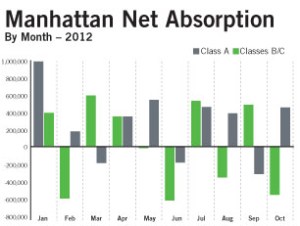2012 Shaping Up To Be Worst Year For Absorption Since 2009
By Jotham Sederstrom November 22, 2012 7:30 am
reprintsNet absorption (net change in occupied space) wrapped up the first 10 months of 2012 at a little more than 1.6 million square feet.
It could be worse … but it could also be better.
This year, firms haven’t been expanding in or relocating to Manhattan at the same speed they did even in 2010 and 2011. And unless some growth explosion happens over November and December, this will be the worst year for absorption since the sharply negative 2009.

Thus far, it’s been a tale of two markets in 2012: Midtown Class A and essentially everything else. Financial services has remained in the doldrums, and space continues to be added within its primary territory from Bryant Park north to Central Park. That’s been the major reason that the net absorption figure finished in the red in six out of the 10 months of the year to date.
Meanwhile, there’s TAMI (technology/advertising/media/information). It’s kept the Manhattan market humming, though not even TAMI has been “spreading the love” at the speed we saw in 2010 and 2011. That said, for most months this year, the Class B and Class C segments have far outperformed the Class A segment due to TAMI’s predilection for Midtown South (which is 80 percent Class B/C). The one major monthly exception was September, when there was significant Class B availability added in several Midtown and even Midtown South submarkets. The big question moving forward is whether we will see any Sandy effect on net absorption, particularly regarding Class A space in Midtown versus Class A space Downtown.
Short term, firms have done what they have to do for business continuity, even if it means taking a block of sublease space for a few months in Midtown. That, in and of itself, will likely not affect net absorption, as we would look at many such transactions as swing space because it would remain on the market for a longer-term tenant.
Over the long term, however, we’ll just have to wait and see.
Robert Sammons, Cassidy Turley


